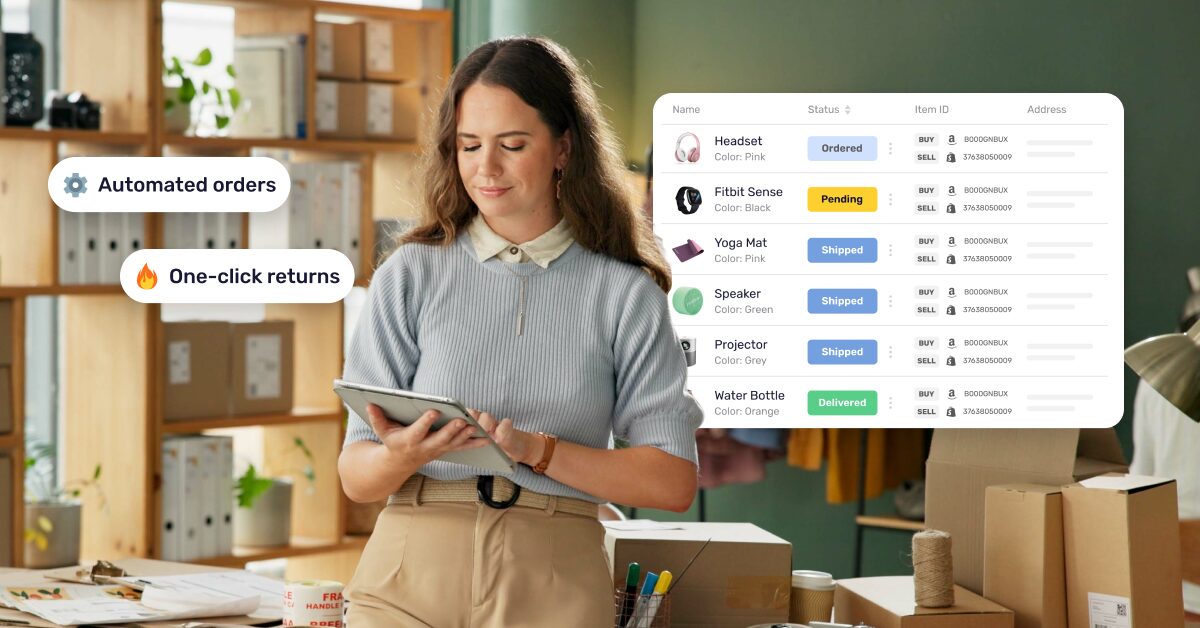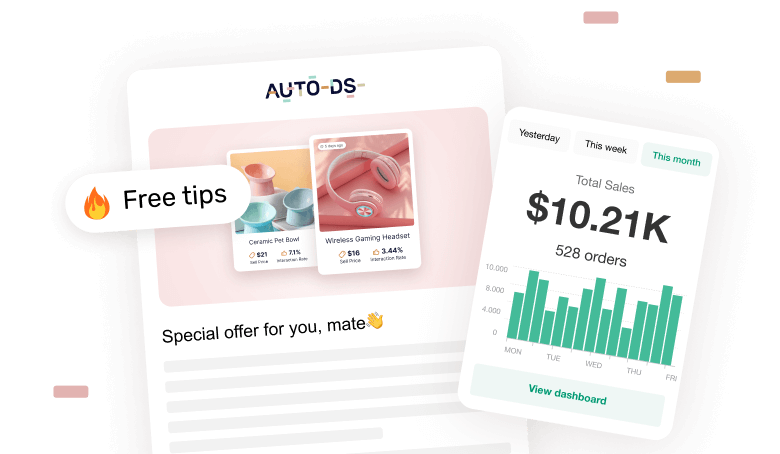Dropshipping fulfillment is everything that happens after a customer hits “buy”. This includes everything from shipping and tracking to handling returns. Unlike traditional e-commerce, you don’t actually manage inventory. But you do handle the overall experience, making sure the product arrives safely.
That’s where automation tools come in. They help you stay organized, save time, and keep customers happy. For example, AutoDS automates order processing, tracks shipments in real time, and centralizes the entire dropshipping process into one single platform.
In this guide, we’ll walk you through how dropshipping fulfillment works and how to do it right. We’ll also cover common pitfalls to avoid and the best tools to make fulfillment and dropshipping as effortless as possible.
Fulfillment = everything that happens after the “Buy Now” button. It’s the process of getting an order from a supplier to your customer—shipping, tracking, returns, and all the behind-the-scenes magic.
As a dropshipper, you don’t handle the product, but you do handle the experience. Fulfillment is your responsibility.
Automation is the key to dropshipping success. With tools like AutoDS, you can automate everything from order forwarding to tracking updates—no manual logistics.
Suppliers handle half the work in dropshipping fulfillment. Make sure they are fast and reliable. Always have more than one to stay flexible and avoid stockouts.
What Is Dropshipping Fulfillment?
Dropshipping fulfillment is everything that happens behind the scenes after someone places an order on your store. It’s the process of getting that product from your supplier to your customer. The goal? Delivering products successfully while staying as hands-off as possible on your end.
Because here’s the thing about dropshipping: you, the seller, don’t actually hold any inventory. You’re just the one connecting the buyer with the supplier. This means that it’s on you to make sure everything feels smooth, fast, and reliable. Even if you never really touch the product yourself.
How? By choosing reliable suppliers, making sure the order is forwarded correctly, handling complaints and returns quickly, and more (we’ll dive deeper into this a bit later). For now, here’s what the order fulfillment process usually looks like, from purchase to doorstep:
- Your customer places an order on your store.
- You, the seller, forward that order to your supplier.
- Then, the supplier picks your order, packs the product, and ships it straight to your customer. So, no, the dropshipper is not at all involved in this step, avoiding inventory, shipping, and all things logistics.
- Finally, your customer receives the order.
- They may or may not request a return. In that case, the process continues until the product makes it back to the supplier, and you refund the customer.
You’ve got two ways to handle drop-ship fulfillment: the manual way or the automated way. Manual means forwarding each order yourself, updating tracking info, and crossing your fingers that nothing slips through the cracks. Automated? That’s where tools like AutoDS step in to automate each step of the fulfillment workflow, from syncing orders to tracking updates.
Tired of managing orders, tracking, and returns by hand? Let AutoDS handle it all for you → [Start your $1 trial]
Either way, when done right, it’s easy as ABC. Done wrong, and expect customer complaints, delayed deliveries, and headaches. Nobody wants that. That’s why having a solid fulfillment and dropshipping system is key if you want your dropshipping business to scale and grow.
Why Effective Fulfillment Matters in Dropshipping
Dropship fulfillment plays a huge role in how people experience your brand. Fast delivery, real-time tracking, and nice package conditions? That’s what earns trust, good reviews, and keeps customers coming back for more. But slow shipping or poor packaging? That might lead to complaints and lost customers.
And it’s not even just about customer satisfaction. A solid fulfillment and dropshipping process keeps your day-to-day operations in place. Accurate inventory helps you avoid overselling. Good supplier relationships mean fewer headaches. And a clear process for handling returns keeps you in control.
All in all, fulfillment isn’t just a backend task. It’s the heart of a reliable dropshipping setup.
Core Components of a Smooth Dropshipping Fulfillment System
Want dropshipping fulfillment to flow effortlessly? There are a few key pieces you need to have in place. Next, we’ll break them down with best practices for you to build a strong fulfillment system.
1. Supplier Selection and Fulfillment Capability
Here’s the harsh truth: your supplier can either make you look like a pro or totally wreck your customer experience. There are hundreds of suppliers out there, but not all of them will check all the boxes. And what are those boxes, exactly? Fast delivery times, transparent order tracking systems, and shipping zones that match your target market.
Local suppliers usually offer faster delivery and better tracking. But (yes, there’s a but)…. they usually come at a higher price. On the other hand, overseas suppliers (especially from China) tend to have lower costs but slower shipping speeds. So, the best option? Balance both. Offer local shipping for trending products and use global suppliers for more niche items.
📦Supplier’s Tip: Before trusting a supplier with your real customers, give them a test drive. Order something yourself and test the whole experience, from shipping times and packaging to product quality.
2. Integration and Automation
Manual order forwarding? No thanks. Today’s dropshippers rely on dropship fulfillment tools like AutoDS to automate the heavy lifting. These platforms sync your store with your suppliers so that once a customer places an order, it’s automatically sent, processed, and updated.
Less copy-pasting means fewer errors. It also means more time to focus on scaling your business instead of micromanaging every order.
🆕Beginner’s Tip: When looking for dropshipping platforms to automate your logistics, look for a wide variety of supplier connections. This will give you more flexibility, control, and a constant plan B in case something goes wrong (AutoDS connects to +30 global suppliers!)
3. Shipping and Tracking
Shipping is where your customer’s patience gets tested. And when patience runs out, guess who gets the angry emails? Yep, you. Not the supplier.
It doesn’t matter if you offer standard or express shipping. Either way, make sure delivery estimates are realistic and that you are delivering the right tracking numbers. When customers can follow their order from warehouse to doorstep, they’re way less likely to flood your inbox with “where’s my order” emails.
4. Packaging and Branding
Just because you’re not the one shipping the item doesn’t mean unboxing has to feel generic. Good dropship fulfillment should deliver a great experience (or, at least, make sure the package is decent). Think branded inserts, custom packaging, or even as little as a thank-you card.
Some AutoDS private suppliers let you add personal touches, like cards, so your package doesn’t feel like it came from a random warehouse. And, honestly, it’s those small details that turn one-time buyers into loyal customers.
5. Returns and Customer Service
Dropship fulfillment doesn’t end once the order is processed. Returns are part of the game, too. But messy return processes? Those are optional. A good fulfillment includes a clear return policy and a step-by-step guide for customers.
Decide early on: will the supplier handle returns, or will you manage them yourself? Either way, be transparent. Customers don’t expect perfection. But they do expect clear answers when something goes wrong.
💡 Pro Tip: Make sure to include a clear, easy-to-find page on your store with return information, shipping times, and contact details. Bonus points if you write in plain, friendly language.
6. Order Monitoring and Analytics
Again, the fulfillment process doesn’t stop at “Fulfill order”. To really optimize it, don’t just set it and forget it. Monitor performance using reports and analytics. Look at delivery times, missing item reports, refund rates, and supplier reliability. Spotting patterns can help you fix problems before they become expensive and find areas for improvement.
Common Fulfillment Pitfalls And How to Avoid Them
Even with automation and great tools, things don’t always go according to plan. Here are some of the most common dropshipping fulfillment mistakes that can derail your perfectly crafted workflow. But hey, no worries—we’ll also include how to stay one step ahead to avoid them.
- Using unreliable suppliers. Always vet your suppliers before committing. Order samples, check processing times, and don’t rely on reviews alone. Remember: suppliers are your partners. Choosing the right ones makes all the difference.
- Long shipping times. Be upfront about delivery estimates on your product pages. If something’s coming from overseas, set clear expectations and offer tracking to ease the wait. Bottom line, be transparent and honest. And, again, choosing the right suppliers is key to delivering on time.
- Miscommunication with suppliers. Keep them in the loop. Experiencing order spikes? Have a specific custom request? Don’t assume they know what you need. Spell it out.
- Missing tracking numbers. Classic! Customers want to know where their stuff is. Use automation tools or manually send tracking numbers to keep everyone in the know.
These are common mistakes everyone can make. But becoming a dropshipping pro is not just about avoiding common mistakes. It’s also about being one step ahead with smart moves for actually scaling in the long term.
Here are some advanced strategies for high-volume fulfillment:
Work with multiple suppliers or warehouses to prevent running out of stock. This also helps you reduce delivery times based on where your shoppers are located. For instance, if a customer is ordering from the US, use US-based warehouses. But if you also have customers in Europe, it’s good to have trusted suppliers in that region as well, so shipping times are shorter and you don’t have to deal with customs.
Also, use pre-ordering or stock buffering for fast-moving products. This means either securing inventory from your supplier in advance so it’s ready to ship the moment an order comes in, or creating a small stock base to avoid overselling when demand spikes. Both strategies help you stay ahead of delays and keep your customers (and your stress levels) in check.
Last but not least, offer tiered shipping options. For example, you can have standard, express, or even same-day local pickup if you’re working with local fulfillment partners. More options = happier customers.
Best Tools for Dropshipping Fulfillment
There are plenty of tools out there promising to simplify dropshipping fulfillment. But not all of them deliver the same level of automation, supplier diversity, or reliability. Let’s take a look at some of the most popular platforms.
AutoDS
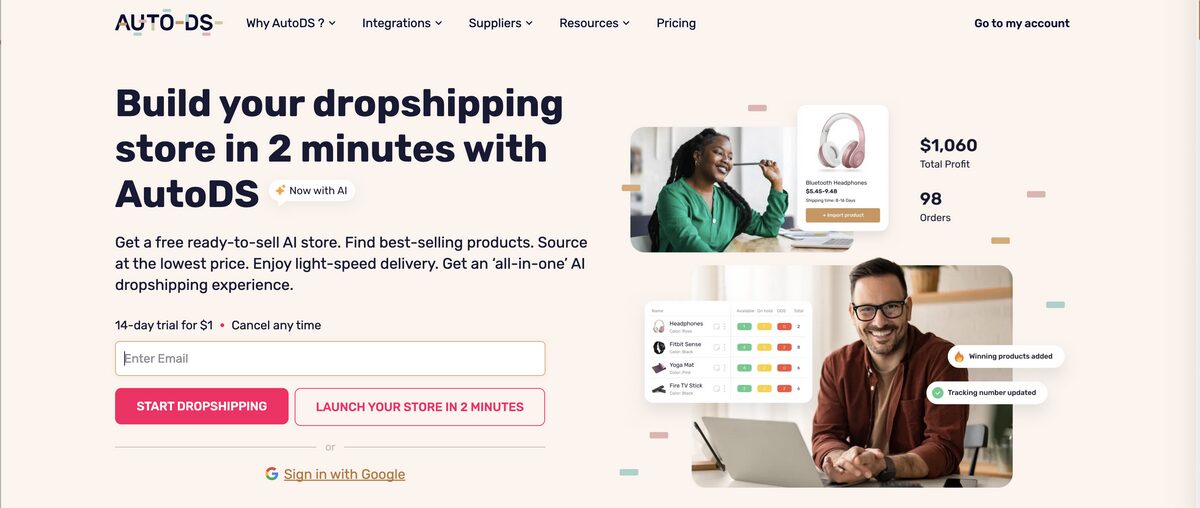
If you’re looking for a tool that covers every single step of drop-ship fulfillment, this is it. AutoDS is an all-in-one dropshipping platform that automates order processing, tracks shipments in real time, and handles returns without lifting a finger.
From the moment the customer clicks “buy” to the second their package arrives, AutoDS keeps everything running behind the scenes so you don’t have to. It offers two fulfillment options:
- Fulfilled by AutoDS, where the system handles everything for you—literally. It includes ordering, tracking, and customer updates using AutoDS’s buyer accounts.
- Automatic order fulfillment, which uses your own buyer accounts, but still automates the order forwarding and tracking updates.
The best part? AutoDS isn’t just an order and fulfillment solution. It’s an end-to-end dropshipping platform. It connects you to private suppliers and global retailers (like Amazon, Walmart, eBay, Shein, and more), and integrates with multiple selling channels (like Shopify, Etsy, Amazon, and WooCommerce).
Plus, it centralizes all your orders into one business dashboard, helps you source and import products, monitors pricing and stock, lets you optimize your listings with AI, and more. All from a single platform.

So, how does it stack up against other tools in this list? All in all, AutoDS offers the most complete fulfillment solution, especially if you’re looking to scale fast, access multiple suppliers, and reduce manual operations with full automation.
Spocket
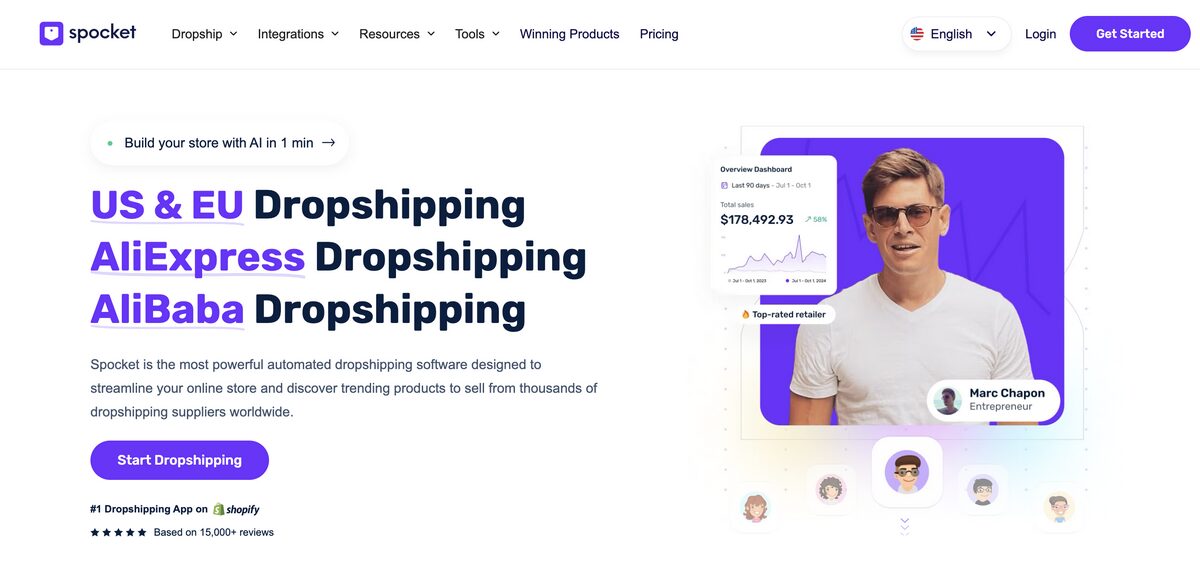
Spocket is a dropshipping platform known for connecting sellers with US and EU-based suppliers. The outcome? Faster shipping times in these regions and often better product quality. Plus, it offers branded invoicing for an authentic touch.
It also offers automated order fulfillment. That said, Spocket lacks advanced automation features that truly make the fulfillment process hands-off. For instance, you must manually review and checkout each order to trigger the supplier request, making it a bit challenging as you scale.
So, while it offers automation and access to local suppliers, AutoDS wins against Spocket with advanced, end-to-end fulfillment, especially with Fulfilled by AutoDS, where you don’t even have to touch the order status.
Zendrop

Zendrop focuses on user experience and offers a clean interface with options like private labeling and fast shipping. It also includes automated order fulfillment, but it does so for its own US and China-based warehouses.
All in all, Zendrop’s supplier network is more limited compared to AutoDS’s +30 supported suppliers. This directly impacts fulfillment: fewer suppliers mean fewer product options, less flexibility with shipping times, and limited reach across global markets.
Plus, Zendrop is missing advanced automation capabilities that complement the dropshipping workflow, like dynamic pricing or AI-powered optimization tools.
In short, while it offers branding features and solid local shipping, AutoDS stands out against Zendrop with more supplier variety and better fulfillment flexibility.
DSers
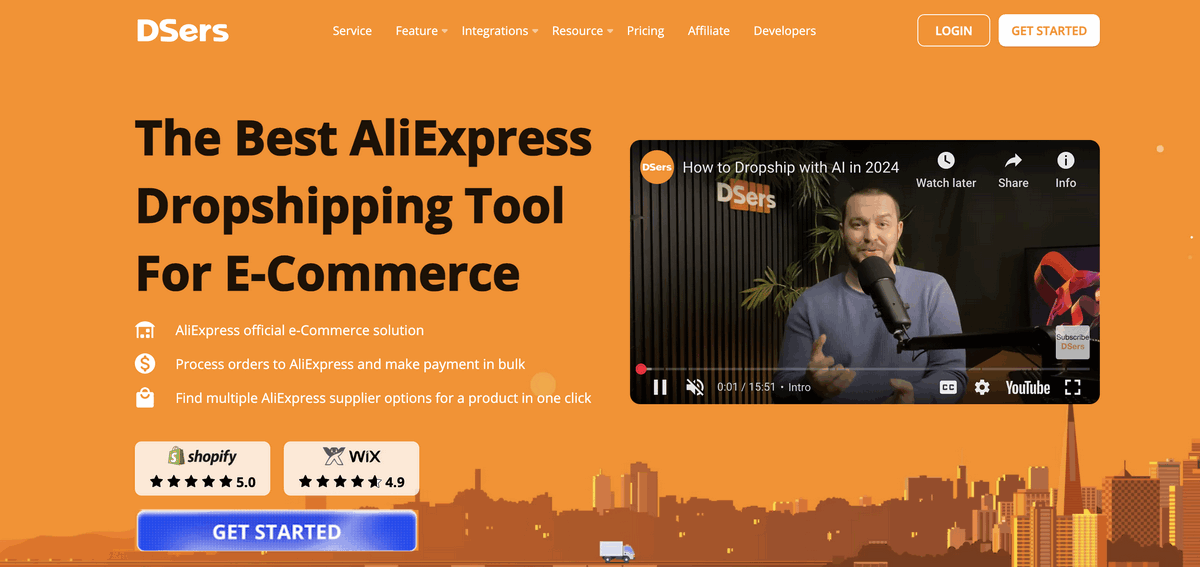
DSers is the official AliExpresspartner. When it comes to automation, it allows you to place bulk orders and track shipments. You can also map multiple suppliers to one product, giving you options if stock runs out.
However, this is all exclusive to AliExpress-based dropshipping. And while that’s a good thing for some sellers, it’s also its biggest limitation—it relies entirely on AliExpress. The result? You have way less flexibility when it comes to choosing suppliers, speeding up shipping times, or customizing packaging and branding.
So, bottom line: It gets the job done for AliExpress-focused stores. But AutoDS goes a step further than DSers with more supplier diversity and higher automation throughout the dropshipping workflow.
CJ Dropshipping

CJ Dropshipping is both a supplier and a fulfillment center, offering product sourcing, warehousing, and shipping. It’s flexible, with options for custom branding and private labeling, and has warehouses in multiple countries for faster delivery.
The drawback? CJ dropshipping lacks full automation for the entire dropshipping process. It does offer automated fulfillment, but it’s missing other features that improve the overall workflow. For example, a full business dashboard for advanced inventory management, dynamic pricing, and AI-powered optimization tools.
Long story short? It’s a solid option for sourcing, branding, and fulfillment. But AutoDS is a better pick than CJ Dropshipping for more automated workflows and time-saving automation. Need more proof? Check out this AutoDS vs. CJ Dropshipping vs. Oberlo 2026 comparison.
Virtual Assistants
Another way to handle fulfillment is through a virtual assistant. This is a mix of both worlds: it involves manual fulfillment and a human touch, without actually taking up your time—you just hire someone else to do it.
It’s especially useful for placing orders, updating tracking, and managing returns, as it offers flexibility and personalization. But it also takes more time. And, most importantly, it leaves lots of room for error. Plus, training and managing a virtual assistant doesn’t happen overnight.
So yes, virtual assistants can help, but why rely on manual input when you can actually automate the whole thing? Tools like AutoDS automate everything your virtual assistant would do, way faster, without the monthly salary and the potential errors.
Frequently Asked Questions
How long does dropshipping fulfillment usually take?
How long dropshipping fulfillment takes depends on where your supplier is based. US or EU-based suppliers deliver within 2-7 days. Overseas suppliers, especially in China, may take 7-21 days. For higher flexibility, partner with dropshipping platforms like AutoDS, which give you access to a wide range of suppliers.
Can I automate my dropshipping fulfillment process?
Yes, you can automate your dropshipping fulfillment process. Tools like AutoDS let you automate order forwarding, tracking updates, and even returns. You can either use your own buyer accounts or Fulfilled by AutoDS, which handles everything for you.
What should I do if a supplier delays fulfillment?
If a supplier delays fulfillment, reach out to them to get clarity on the delay. Then, be transparent with your customer. Send a quick update with a revised delivery schedule. Meanwhile, consider switching suppliers if delays become a pattern. Choose dropshipping platforms with access to a wide variety of options, so you can stay flexible.
Conclusion
Dropshipping fulfillment isn’t the most exciting part of running your store, but it’s the part your customers feel the most. And the part that, when done right, will keep bringing in sales. At the end of the day, customers just want their package to arrive on time, in one piece. Bonus? They want a reliable tracking number so they can manage their anxiety. That’s it.
And for you, the seller, that means setting up a system that takes care of the heavy lifting (without creating a daily to-do list of forwarding orders and chasing suppliers). The solution? AutoDS automates your entire fulfillment workflow, syncs tracking info, and gives you full control through a full business dashboard. If fulfillment is the engine, AutoDS is the autopilot. You focus on growth, let the system handle the rest.
Want to keep leveling up your dropshipping game? Here are three articles you can check out:






